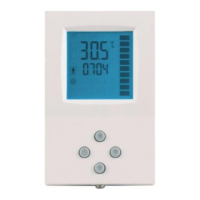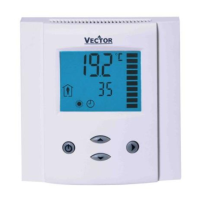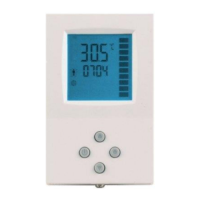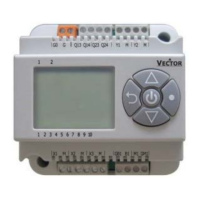TCY3-T1102 Engineering Manual
Doc: 70-000003 V1.0, 20150710 © Vector Controls GmbH, Switzerland Page 14
Subject to alteration
Output configuration
General
An output must be assigned to a function or a control loop using the OP parameter set. Assigning an output to a control
function will automatically activate the respective function. Unassigned functions are not active.
Alarms: Define how the output should respond to a specific alarm condition.
Alarm function
The alarm setting defines how the output should respond to a specific alarm
condition. Choose from low limit, high limit input conditions or in case any alarm
happened. The output can be activated or deactivated in case of alarm.
The alarm situation takes precedence over operating state and calculated output
signal.
Analog outputs
The analog outputs may be configured with jumpers for 0-10 VDC or 0-20 mA control signals. The
jumpers are located on the front side of the power part. The drawing on the right indicates the jumper
placement for each signal type. The factory setting is 0-10 VDC. Only place the jumper vertically. Only
place one jumper for one signal. The signal range can be specified in software by setting a minimum and
a maximum limit. The limits are in percent of the full range.
Special functions of the analog output:
Positions the output directly with a set point. The number of positioning steps can be
selected: 2, 10, 100 steps
Dehumidifying
(only for 4-pipe systems)
The maximum value is taken of both direct acting PID sequences (cooling and
dehumidifying). Cooling will start to operate if the humidity gets too high, even if there is
no cooling need, thus the heating will be forced to come into play, which in turn
dehumidifies the air.
In the VAV control sequence, at peak cooling the airflow set point is the maximum amount
of air the VAV box is set to deliver. It may be adjusted through the maximum limit on the
analog output (1A03 or 2A03). As cooling requirements decrease, airflow dwindles until it
reaches its minimum set point. This set point will be based on the airflow needed at design
cooling and is typically 10% to 15% of maximum cooling airflow. Minimum airflow can be
adjusted by the minimum limit on the analog output (1A02 or 2A02). When it reaches
this minimum, the system is in its dead band and is neither heating nor cooling. As the
system moves into heating mode, the airflow rate increases until it reaches the maximum
airflow required for heating mode. This is typically 30 to 50% of maximum airflow of
cooling mode. The parameter for this is called VAV function: maximum limitation in
heating mode (1A05 or 2A05).
Sensor and set point
feedback
Internal humidity and temperature sensor values as well as set points may be transmitted
on the analog outputs. Minimum and maximum value of the feedback value may be set for
loop 1 (temperature), loop 2 is fixed to 0…100%. The alarm output level will be activated
in case a sensor is in error mode.
Priority for output control
1. Alarm level high,
2. Operation mode OFF
3. Control function

